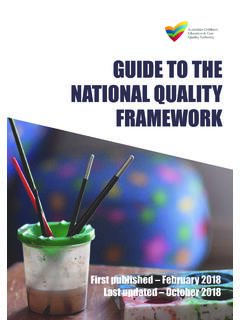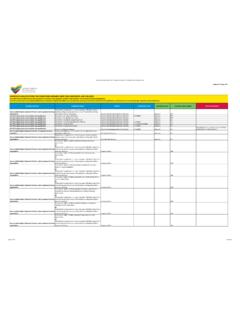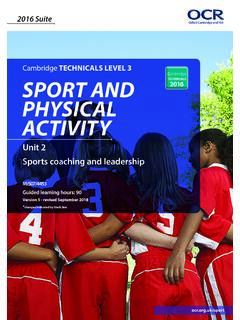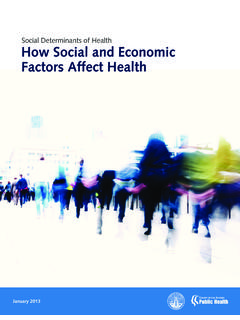Transcription of An environment for learning
1 1 Our philosophy informs practiceSimultaneous indoor and outdoor programs can test our values and philosophies about learning and teaching, the design of our facilities and how we staff our programs. We need to stop and ask ourselves and our staff: What is my understanding of children s learning ? Do children learn as much outside as inside? Do we see outside play as merely for children to let off steam and give them opportunities to take physical risks? Do children learn more through a structured approach indoors, such as table top activities and group time? What if parents say they can t just play all day ? Should educators be active participants in children s learning , both indoors and out? Do we currently plan for learning inside and outside differently? Why? In what way is our planning different? Is our planning more about the activity Lego vs.
2 Water play rather than planning for the learning children might gain from an experience? NQS PLP e-Newsletter No. 30 2012 An environment for learningMy story:Returning to the workforce after being at home with four young children, I reflected not only on my previous early childhood teaching practices and knowledge but also on what it had been like for me and my children being together at home a privilege not all families can enjoy. This reflection highlighted for me some of the principles that would be important for all children in care outside their family home. In any service I work in, some of the things that really matter for children are: relationships choices being able to move freely between indoors and outdoors connecting with siblings unhurried time to pursue their own interests family and community connecting with nature time to be alone.
3 , I realised that any future environment I provided for children in my care had to do these things and more. Setting up an indoor and outdoor learning program was for me the next logical step. Judy RadichSetting the sceneTraditionally, early childhood care and education services have offered children opportunities to play for periods inside and periods outside. The Early Years learning Framework (EYLF) and the National Quality Standard (NQS) do not make distinctions between indoor and outdoor locations. Instead, these documents focus on the learning that occurs and ask educators to think more deeply about how, what and when children learn in the early childhood EYLF asks us to reflect on and rethink the way we provide for learning , with an emphasis on meeting the individual needs of young children and working in partnerships with families.
4 The NQS highlights environments for learning in various Quality Areas (QAs): QA1 Educational program and practice; QA2 Children s health and safety; and QA3 physical environment . The other Quality Areas relating to staffing, relationships, partnerships with families and leadership also contribute to the quality of the program and children s requires just as much planning for learning as indoors. We need to plan for learning not the previous EYLF PLP e-Newsletter on health, safety and wellbeing highlights the significance of a clean, safe and sustainable physical environment as a vital component of quality for children, educators and families. It also emphasises, as the EYLF and the NQS do, that the environment should promote each child s wellbeing and support their growing competence, confidence and independence (ACECQA, 2011, p.)
5 50).Setting up indoor and outdoor spaces with learning in mind demonstrates that play can be a catalyst for learning everywhere. This involves setting up each space to encourage, support, and challenge children to explore, investigate, problem solve, imagine, create and experiment. When educators are actively engaged with children and experiences, learning is deepened and extended. Planning for educator engagement indicates that we realise that important learning will not just happen by osmosis. In an article soon to be published in Every Child, Luke Touhill (Touhill, 2012, in press) reminds us When, for instance, we talk about the learning involved in sand and water play, we typically find ourselves talking about the potential for all kinds of science and maths learning as children measure and pour or observe what floats and what doesn t.
6 All of which is true sand and water do offer great opportunities for learning about measurement and other science and maths concepts. But just because such learning is possible it doesn t automatically mean that it happens. The physical environment indoors and outdoorsThe physical environments and overall atmospheres of our services support and enhance each child s learning , through enabling positive relationships and effective communication. The design of the physical space plays a primary role in facilitating the development and maintenance of relationships throughout the education and care community, with indoor and outdoor spaces sending a message that getting to know one another is important, and constructing expectations of how we work, live and play in that environments are comfortable, interesting, attractive and appropriate for the child, holding intrinsic interest and giving children myriad ways to practise and refine skills across all aspects of learning .
7 A suitable environment for a young baby will be very different in some ways from one that is suitable for a four- or five-year-old, although some features will be the same. Settings which run indoor outdoor programs and give children the power to decide when and where they go, may choose to section off part of the space so babies still feel a sense of belonging while their particular requirements for safety are spaces need careful planning, particularly as they need to be flexible enough to accommodate children s changing interests, needs and increasing skills and we allow children to make choices and decisions and we are active participants in their play, we are implementing the practices outlined in the EYLF (DEEWR, 2009, pp. 4 5): We are fostering children s capacity to understand and respect the natural environment and the interdependence between people, plants, animals and the land.
8 Responsive learning relationships are strengthened as educators and children learn together and share decisions, respect and trust. At Cooloon Children s Centre in Tweed Heads, we run an indoor outdoor program with a shared yard for infants, toddlers and preschoolers. Indoors and outdoors, most equipment is labelled and out on open shelves with a photo of the items so children are able to select the specific materials they wish to play with. Our educators do not make these decisions each morning; children do. So it is very common for several children to be building with blocks, others constructing with Lego and another child completing a puzzle, all side by side on the floor inside, while others may be involved in carpentry, small group work or more physical play for children is about focusing on the learning , not just the activity or setting up places that might have the potential for learning without ensuring the learning occurs.
9 3 Similarly, Element of the NQS Quality Area 1, Educational program and practice, states that each child s agency is promoted, enabling them to make choices and decisions and influence events and their world (ACECQA, 2011).These possibilities can be realised in a program where children move freely between playrooms and the indoor and outdoor spaces. Jan and her team of educators at Joey s believe working in this way enables them to plan for children s learning in a more holistic sense and enact the Principles and Practices that are given priority in the EYLF. In discussing physical environments, Quality Area 3 of the NQS reinforces this approach. Element states that facilities are designed or adapted to ensure access and participation by every child .. and to allow flexible use and interaction between indoor and outdoor space ( ACECQA, 2011, p.)
10 10).Risk takingOur thinking about safety has often been limited to considering risk in terms of the outdoors and the physical environment , but we need to consider how we can help children and families to feel safe enough to take risks in all kinds of environments. Our task as educators is to understand that it is vital for children to continually test the limits of their physical , intellectual and emotional capacities and allow children the freedom to take risks in their play, while balancing the need for children to be safe. As Cheryl Greenfield (2004) says, Outdoor play provides open-ended, dynamic, varied opportunities which are unpredictable and at times risky. However, the risks and challenges of being outdoors provide rich opportunities for learning , problem-solving and developing social competence .Implications for educators Bringing this discussion on environments to a conclusion, it seems timely to suggest that educators consider questions such as: How does your learning environment demonstrate your knowledge of how young children learn?
















